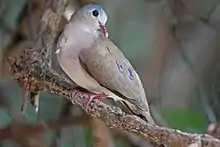Blue-spotted wood dove
The blue-spotted wood dove (Turtur afer) is a species of bird in the family Columbidae. It is abundantly present throughout Africa south of the Sahel; it is partially present in East Africa and absent in southern Africa.
| Blue-spotted wood dove | |
|---|---|
 | |
| In Gambia | |
| Scientific classification | |
| Kingdom: | Animalia |
| Phylum: | Chordata |
| Class: | Aves |
| Order: | Columbiformes |
| Family: | Columbidae |
| Genus: | Turtur |
| Species: | T. afer |
| Binomial name | |
| Turtur afer (Linnaeus, 1766) | |
| Synonyms | |
| |
Taxonomy
In 1760 the French zoologist Mathurin Jacques Brisson included a description of the blue-spotted wood dove in his six volume Ornithologie based on a specimen collected in Senegal. He used the French name La tourterelle de Sénégal and the Latin Turtur senegalensis.[2] Although Brisson coined Latin names, these do not conform to the binomial system and are not recognised by the International Commission on Zoological Nomenclature.[3] When in 1766 the Swedish naturalist Carl Linnaeus updated his Systema Naturae for the twelfth edition, he added 240 species that had been previously described by Brisson.[3] One of these was the blue-spotted wood dove which he placed with all the other pigeons in the genus Columba. Linnaeus included a brief description, coined the binomial name Columba afra and cited Brisson's work.[4] The specific name afer is the Latin word for "Africa".[5] The species is now placed in the genus Turtur that was introduced in 1783 by the Dutch naturalist Pieter Boddaert.[6][7] The species is monotypic: no subspecies are recognised.[7]
References
- BirdLife International (2012). "Turtur afer". IUCN Red List of Threatened Species. 2012. Retrieved 26 November 2013.CS1 maint: ref=harv (link)
- Brisson, Mathurin Jacques (1760). Ornithologie, ou, Méthode contenant la division des oiseaux en ordres, sections, genres, especes & leurs variétés (in French and Latin). Volume 1. Paris: Jean-Baptiste Bauche. pp. 122–123, Plate 10 fig 1. The two stars (**) at the start of the section indicates that Brisson based his description on the examination of a specimen.
- Allen, J.A. (1910). "Collation of Brisson's genera of birds with those of Linnaeus". Bulletin of the American Museum of Natural History. 28: 317–335.
- Linnaeus, Carl (1766). Systema naturae : per regna tria natura, secundum classes, ordines, genera, species, cum characteribus, differentiis, synonymis, locis (in Latin). Volume 1, Part 1 (12th ed.). Holmiae (Stockholm): Laurentii Salvii. p. 284.
- Jobling, James A. (2010). The Helm Dictionary of Scientific Bird Names. London: Christopher Helm. p. 35. ISBN 978-1-4081-2501-4.
- Boddaert, Pieter (1783). Table des planches enluminéez d'histoire naturelle de M. D'Aubenton : avec les denominations de M.M. de Buffon, Brisson, Edwards, Linnaeus et Latham, precedé d'une notice des principaux ouvrages zoologiques enluminés (in French). Utrecht. p. 10 Number 160.
- Gill, Frank; Donsker, David; Rasmussen, Pamela, eds. (2020). "Pigeons". IOC World Bird List Version 10.1. International Ornithologists' Union. Retrieved 14 March 2020.
External links
| Wikimedia Commons has media related to Turtur afer. |
